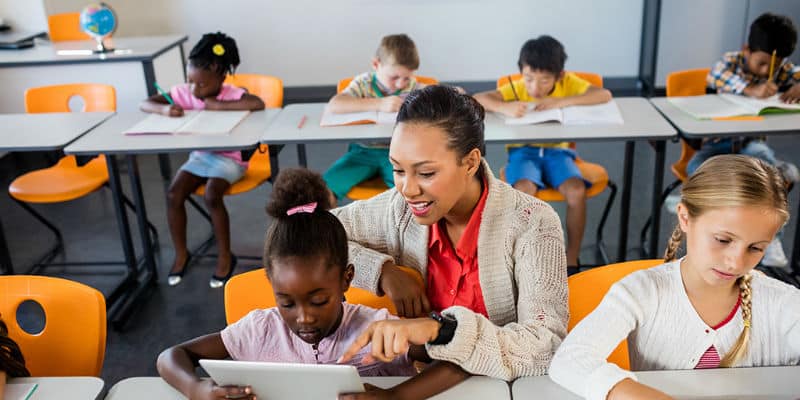A lifetime ago in March, it made perfect sense for edtech companies to make their products free. Schools were thrust into an emergency where their typical instruction was rendered impossible, so companies made it easier for them to grasp new resources in the void.
A handful of organizations’ efforts stand out, however, by taking a different approach: offering free support services, not free stuff. One is the Always Ready for Learning Network, which rallied funders to support a network of free coaching services for school leaders. Another is Transcend’s Recovery to Reinvention library, which documents the details of remote learning and re-entry models in student-centered schools.
These offerings help schools build new ways of doing things—not just adopt new tools. Here’s why that makes a difference:
Resources can change schools’ capabilities—but only when paired with new processes
Without resources, schools can’t deliver what stakeholders expect of them. It’s pretty hard to teach literacy without reading material. Schools need effective teachers to support students’ learning and development. Inclusive classrooms need culturally-responsive curriculum. And online instruction doesn’t work unless students have access to the Internet and devices. So there’s an important case to be made for ensuring schools have adequate resources, especially when faced with challenging times and circumstances. That’s especially true when an economic recession threatens to slash the budgets in schools that are already inequitably funded.
Yet, some leaders don’t just want schools to operate adequately—they want to see schools fundamentally change how they operate and what they offer. But lasting change won’t happen by spending more money, acquiring new technology, or adopting new tools because the drivers of schools’ capabilities are more complex. Many barriers to change stem from processes that are deeply embedded in how schools operate, like scheduling and staffing, curriculum development, discipline policies, and instructional models. By themselves, more new resources won’t change schools’ capabilities—resources need to power new processes.
To understand why, one needs go no further than this headline from the BBC in 2015: “Computers ‘do not improve’ pupil results, says OECD.” The release of the referenced “Students, Computers, and Learning” report rankled the edtech community by finding that more frequent computer use in schools was associated with lower results. The Organisation for Economic Co-operation and Development (OECD) designed the study to evaluate the impact of a resource—computers—on schools’ capabilities but didn’t take into account the variety of processes by which teachers used computers to support student learning. As a result, the study’s findings are unsurprising: adding more resources, although relatively straightforward, has the least potential to fundamentally transform how schools operate.
On the other hand, when educators integrate new resources—such as technology—with new processes, they can have a powerful impact on capabilities. For example, Teach to One: Math, a program that uses technology to optimize middle school students’ individual daily learning plans for math instruction, has been shown to increase student achievement by up to 53% beyond national averages. Because the approach combines new resources with new instructional processes that depart from whole-class pacing and teacher-led instruction, schools that adopt the program are more likely to achieve desired results.
Some of today’s calls for change focus on urgently providing schools with new resources—such as WiFi hotspots, video conferencing, culturally-relevant curriculum, or counselors in place of school resource officers—but not the work of integrating those new resources into new and better processes. It can be tempting to prophesy that these new resources will seed lasting changes in how schools operate. But as schools confront the challenges ahead of them this year, it’s critical to remember the role that processes play in redefining schools’ capabilities.
Funders and policymakers: Unlock dollars for more than just resources
Funders and policymakers should balance efforts to ensure adequate resources for schools with funding for schools to develop new processes. Philanthropic funders can direct dollars to fund long-term professional learning, strategic advising, and innovation, making it more likely that educators develop new processes that are good enough to replace existing ones. State leaders should also create more flexible funding for interested schools to adopt full-stack models whose solutions integrate key resources and processes, such as what New Classrooms (the creators of Teach to One: Math) offers.
School leaders: Focus on the hunt for new processes
Educators should take advantage of the Always Ready For Learning Network, which is free until at least October. They can also find models for new processes ranging from schedules to social-emotional supports in the Recovery to Reinvention Library. And when considering new edtech, don’t stop at Khan Academy—look for tools that make learning content interdependent with new ways to learn, like how Family Playlists structures a way for kids and families to learn together.
In the upheaval of 2020, school system leaders must balance the urgency of identifying adequate resources with the skepticism that more resources alone will lead to meaningful change. Resources can be purchased or coerced, but it’s processes that most influence schools’ capabilities—and processes must be built, not bought.
We’re working on a new report with additional insights that will help school system leaders understand the dynamics at play when schools change, and how to make desirable changes persist for the long term. Sign up for our Christensen Institute newsletter to learn when our new report is released this fall.



